Potřebujeme váš souhlas k využití jednotlivých dat, aby se vám mimo jiné mohly ukazovat informace týkající se vašich zájmů. Souhlas udělíte kliknutím na tlačítko „OK“.
ASTM E724-98(2012)
Standard Guide for Conducting Static Acute Toxicity Tests Starting with Embryos of Four Species of Saltwater Bivalve Molluscs
Automaticky přeložený název:
Standardní příručka pro dirigování statické akutní toxicity Zkoušky Od embrya čtyř druhů slané vody mlžů
NORMA vydána dne 1.12.2012
Informace o normě:
Označení normy: ASTM E724-98(2012)
Poznámka: NEPLATNÁ
Datum vydání normy: 1.12.2012
Kód zboží: NS-47801
Počet stran: 22
Přibližná hmotnost: 66 g (0.15 liber)
Země: Americká technická norma
Kategorie: Technické normy ASTM
Kategorie - podobné normy:
Mikrobiologie vody
Znečišťování, kontrola znečišťování a konzervace
Anotace textu normy ASTM E724-98(2012) :
Keywords:
acute toxicity test, bivalve mollusc larvae, bivalve molluscs embryos, blue mussel, Crassostrea gigas, Crassostrea virginica, hard clam, Mercenaria mercenaria, Mytilus edulis, oyster, ICS Number Code 07.100.20 (Microbiology of water),13.020.40 (Pollution, pollution control and conservation)
Doplňující informace
| Significance and Use | |||||||||||||||||||||||||||||||||||||||||||||||||||||||||||||||||||||||||||||||||||||||||||||||||||||||||
|
5.1 An acute toxicity test is conducted to obtain information concerning the acute effects of a short term exposure of organisms to a test material under specific experimental conditions. An acute toxicity test does not provide information concerning whether delayed effects will occur. 5.2 Because embryos and larvae are usually assumed to be the most sensitive life stages of these bivalve mollusc species and because these species are commercially and recreationally important, results of these acute tests are often considered to be a good indication of the acceptability of pollutant concentrations to saltwater molluscan species in general. Results of these acute toxicity tests are often assumed to be an important consideration when assessing the hazard of materials to other saltwater organisms (see Guide E1023) or when deriving water quality criteria for saltwater organisms (3) . 5.3 Results of acute toxicity tests might be used to predict acute effects likely to occur to aquatic organisms in field situations as a result of exposure under comparable conditions, except that toxicity to benthic species might depend on sorption or settling of the test material onto the substrate. 5.4 Results of acute tests might be used to compare the acute sensitivities of different species and the acute toxicities of different test materials, and to determine the effects of various environmental factors on results of such tests. 5.5 Results of acute toxicity tests might be useful for studying biological availability of, and structure activity relationships between, test materials. 5.6 Results of acute toxicity tests will depend on temperature, composition of the dilution water, condition of the test organisms, and other factors. |
|||||||||||||||||||||||||||||||||||||||||||||||||||||||||||||||||||||||||||||||||||||||||||||||||||||||||
| 1. Scope | |||||||||||||||||||||||||||||||||||||||||||||||||||||||||||||||||||||||||||||||||||||||||||||||||||||||||
|
1.1 This guide describes procedures for obtaining laboratory data concerning the acute effects of a test material on embryos and the resulting larvae of four species of saltwater bivalve molluscs (Pacific oyster, Crassostrea gigas Thunberg; eastern oyster, Crassostrea virginica Gmelin; quahog or hard clam, Mercenaria mercenaria Linnaeus; and blue mussel, Mytilus edulis Linnaeus) during static 48-h exposures. These procedures will probably be useful for conducting static acute toxicity tests starting with embryos of other bivalve species (1)2 although modifications might be necessary. 1.2 Other modifications of these procedures might be justified by special needs or circumstances. Although using procedures appropriate to a particular species or special needs and circumstances is more important than following prescribed procedures, results of tests conducted by using unusual procedures are not likely to be comparable to results of many other tests. Comparison of results obtained by using modified and unmodified versions of these procedures might provide useful information concerning new concepts and procedures for conducting 48-h acute tests starting with embryos of bivalve molluscs. 1.3 These procedures are applicable to most chemicals, either individually or in formulations, commercial products, or known mixtures. With appropriate modifications these procedures can be used to conduct acute tests on temperature, dissolved oxygen, and pH and on such materials as aqueous effluents (see also Guide E1192), leachates, oils, particulate matter, sediments, and surface waters. Renewal tests might be preferable to static tests for materials that have a high oxygen demand, are highly volatile, are rapidly biologically or chemically transformed in aqueous solution, or are removed from test solutions in substantial quantities by the test chambers or organisms during the test. 1.4 Results of acute toxicity tests with embryos of bivalve molluscs should usually be reported as the EC50 based on the total incompletely developed and dead organisms. It might also be desirable to report the LC50 based only on death. In some situations, it might only be necessary to determine whether a specific concentration is acutely toxic to embryos or whether the EC50 is above or below a specific concentration. 1.5 This guide is arranged as
follows:
Podobné normy: Historická Historická Historická Historická Historická Historická Poslední aktualizace: 18.12.2025 (Počet položek: 2 252 678) |


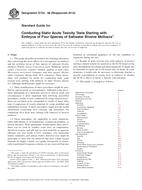
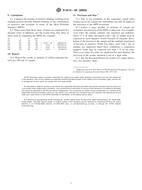 ASTM D4412-84(2009)..
ASTM D4412-84(2009)..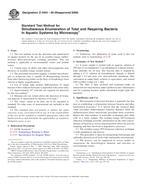 ASTM D4454-85(2009)..
ASTM D4454-85(2009)..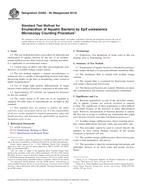 ASTM D4455-85(2014)..
ASTM D4455-85(2014)..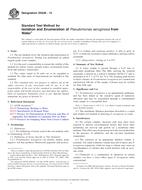 ASTM D5246-13
ASTM D5246-13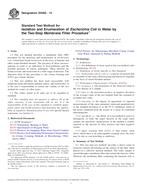 ASTM D5392-14
ASTM D5392-14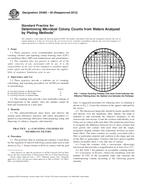 ASTM D5465-93(2012)..
ASTM D5465-93(2012)..
 Cookies
Cookies
